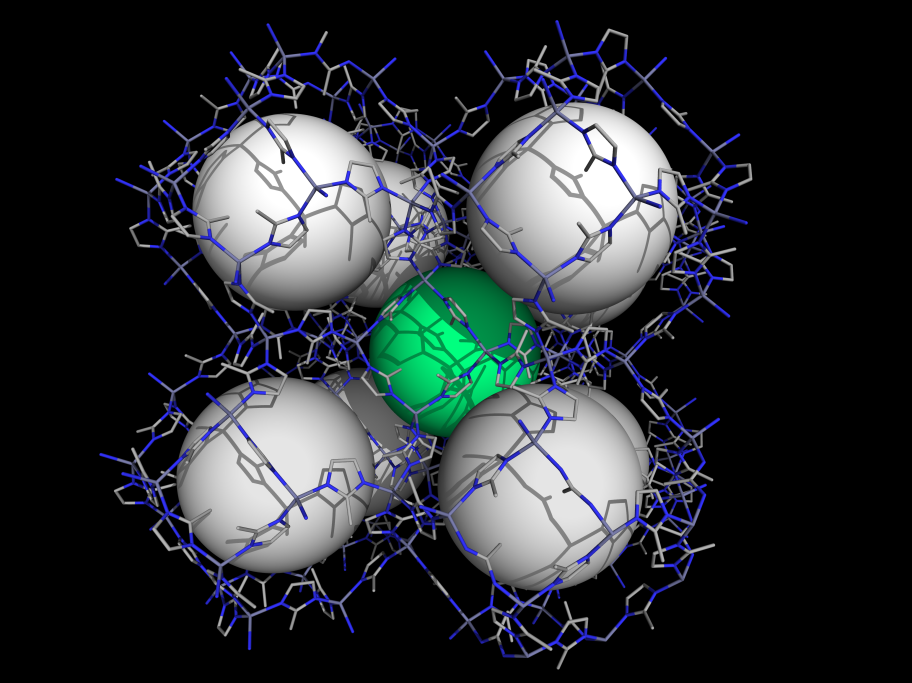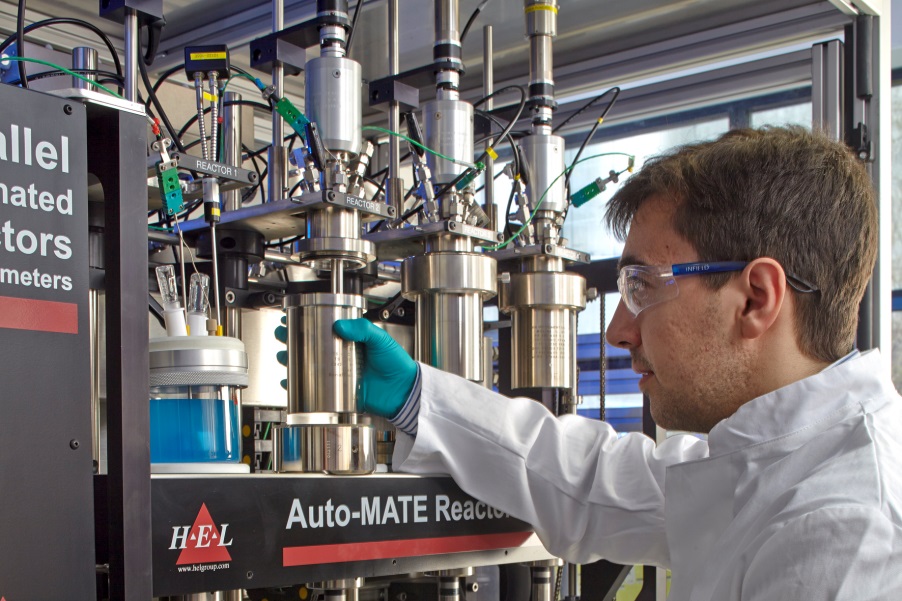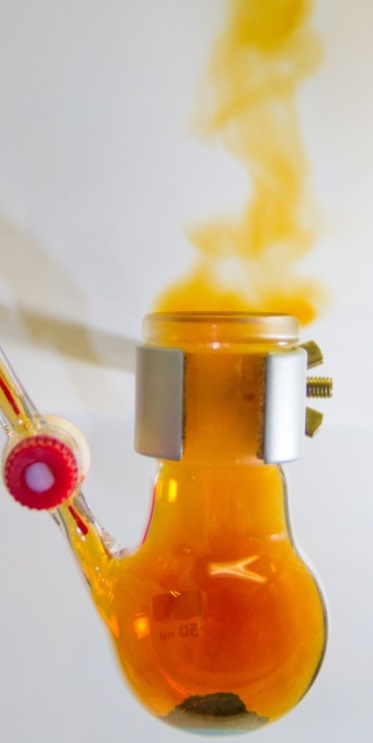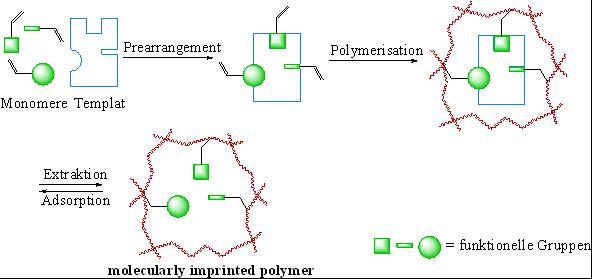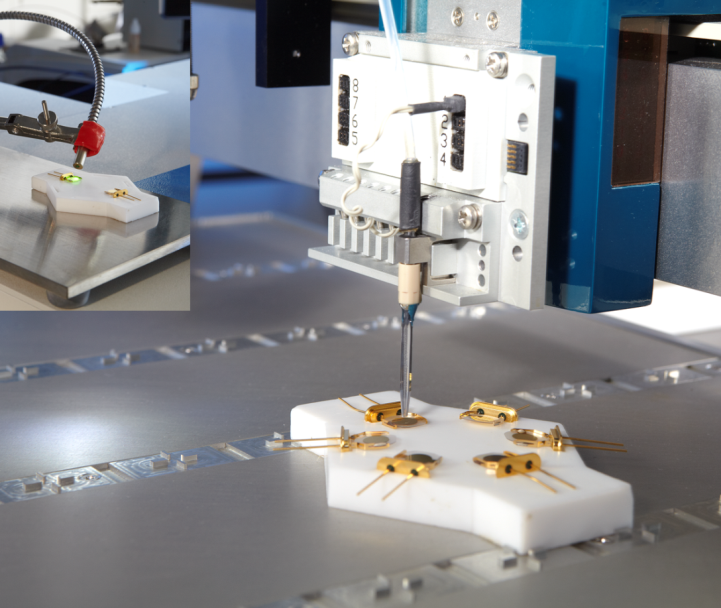Research fields in the area of nanoporous materials include imprinted polymers which can function according to the lock-and-key principle, thus enabling the development of (for example) selective sensors, and metal-organic framework structures, for example for applications in the areas of gas storage, separation techniques and sensor technology.
Nanoporous materials
Metal-Organic Frameworks
Metal-organic frameworks (MOFs) are a new class of microporous materials with large specific surface areas (up to 7000 m2/g) that substantially exceed those of established porous materials like silicates or activated carbon.
Structure
MOFs consist of metallic clusters that are connected by organic linkers (e.g. terephthalate, imidazolate). They offer an infinite array of compositional possibilities, generating a wide variety of MOF substances with very different properties. Porous MOF materials can therefore be used in very different areas of application, in particular gas storage, separation technology, sensors, water treatment, protection and catalysis.
MOF applications
We carry out applied research in the field of metal-organic frameworks, and investigate and test their applicability in various fields, such as the adsorptive separation of toxic and industrial gases (TICs, VOCs), personnel protection, CO2 capture and atmospheric water generation. These results are achieved by developing tailor-made materials with specific structural properties in terms of surface area, pore size and shape, hydrophobicity, mechanical strength, etc.
However, designing, synthesizing and upscaling a material to meet a specific goal involves significant technological risk and implementation costs. MOFs are also used as an active substance in compound materials based on conventional matrices (graphene oxide, activated carbon, zeolite, silica gel). These composites with integrated MOFs minimize the technological disadvantages of the matrix, reducing production costs and improving the performance of the materials. Due to their specific structural composition, MOFs are reported to achieve unprecedented results, enabling the solution of a variety of problems. Their further development allows innovations in the fields of carbon capture, utilization and storage (CCUS), atmospheric water harvesting (AWH), water treatment and exhaust gas treatment.
We use screening procedures conducted either continuously or batch-wise in parallel reactor set-ups, in order to identify promising synthesis routes at a very early stage during the exploration of new MOF materials. Modern analytical methods are available for characterizing the products, in particular the structure, specific surface, adsorption behavior and chemical and thermal stability of the porous materials.
Our offer
- evaluation of the performance of innovative materials for the adsorption and separation of TICs and VOCs
- development and evaluation MOFs for AWH and CCUS
- synthesis and scale-up of MOFs and MOF composite materials
- development, analysis and optimization of customer-specific requirements for MOF processes
Molecularly imprinted polymers
Molecular polymer imprinting is a highly elegant and efficient method of producing functional materials equipped with selective identification characteristics. Using the lock-and-key principle, selective materials can be produced for different applications, such as sensors, purification of mixtures or enrichment.
Advantages and applications
Molecularly imprinted polymers (MIPs) are produced by synthesizing highly cross-linked polymers in the presence of template molecules. In a self-organizing process, the growing polymer skeleton adapts to the molecular model, forming a type of imprint of the molecular template. The geometric adaptation of the polymer and the interactions of the functional groups, for example the formation of hydrogen bonds, make the polymer selective for the template, which means that it can be applied as a selective sensor coating.
At Fraunhofer ICT, MIPs are being developed as sensor coatings for the detection of explosives, and as particles for the enrichment of semi-volatile compounds. Various coating technologies such as nanoplotting, spin coating, screen printing and various synthesis methods (UV polymerization, suspension polymerization, core-shell particles are used. Possible analytes range from explosives or toxic substances, such as herbicides and pesticides, to natural substances such as steroids.
Our offer
- Synthesis of MIP materials for customer-specific target molecules for enrichment / extraction or as selective sensor coatings
- Adjustment or development of coating processes for various sensor surfaces
- Characterization of surface properties and particle size distributions
- Characterization of the adsorption properties of the template used
Projects
MOFSCHUTZ
The aim of the joint project is to develop a new generation of personal protection equipment (filter systems) and respiratory protection mask filters for civil protection and emergency task forces. MOFs are used to adsorb specific airborne hazardous substances in relevant environments. These are mainly substances which cannot be sufficiently adsorbed by the activated carbons (with or without metal salt impregnation) that are normally used in this process, but which nevertheless have a high hazard potential. Examples include hydrogen sulfide (H2S), carbon monoxide (CO), ammonia (NH3), and nitrogen oxides (NOx).
MOFHAUBE
In this Fraunhofer-internal project, innovative MOF-based filter materials are produced. MOF-activated carbon composites have already been produced and their performance has been measured against H2S and NH3. The promising MOF filters produced are tested in a kitchen exhaust hood.
ARTEMIS
A comprehensive feasibility study was conducted concerning the new technology of CO2 capture with MOFs. Several MOF candidates have been identified for different application scenarios, such as flue gas plants, urban CO2 capture and CO2 capture in confined spaces.
WATER HARVESTING
The capacity of some MOF materials to adsorb and desorb water vapor under atmospheric conditions without external energy sources was tested. Experiments on water adsorption and desorption were carried out in climate chambers, and the stability of the tested MOFs after adsorption-desorption was confirmed.
Project REMEDIA
Chronic obstructive pulmonary disease (COPD) and cystic fibrosis (CF) are two very debilitating non-communicable diseases that are of particular interest to consider in parallel in a human exposome study. Their roots are opposite COPD is currently considered to be mainly related to the external exposome, while factors outside of the exposome play a major role in CF. However, COPD and CF share common characteristics such as high phenotypic variability of unknown origin, which prevents good therapeutic efficacy. It is therefore clear that the overall picture must be supplemented by taking into account additional components of the exposome than those currently considered in COPD and CF. Thus, the overall objective of the REMEDIA project is to extend the understanding of the contribution of the exposome, taken as a complex set of different components, to COPD and CF diseases. We will exploit data from existing cohorts and population registries in order to create a unified global database gathering phenotype and exposome info; we will develop a flexible individual sensor device combining environmental and biomarker toolkits; and use a versatile atmospheric simulation chamber to simulate the health effects of complex exposomes. We will use machine learning supervised analyses and causal inference models to identify relevant risk factors; and econometric and cost-effectiveness models to assess the costs, performance and cost-effectiveness of a selection of prevention strategies. The results will be used to develop guidelines to better predict disease risks and constitute the elements of the REMEDIA toolbox. Deciphering the impact of environmental components throughout life on the phenotypic variability of COPD and CF could represent a major breakthrough in reducing morbidity and mortality associated with these two noncurable diseases and would lead to the identification of modifiable risk factors on which preventive action could be implemented.
 Fraunhofer Institute for Chemical Technology ICT
Fraunhofer Institute for Chemical Technology ICT